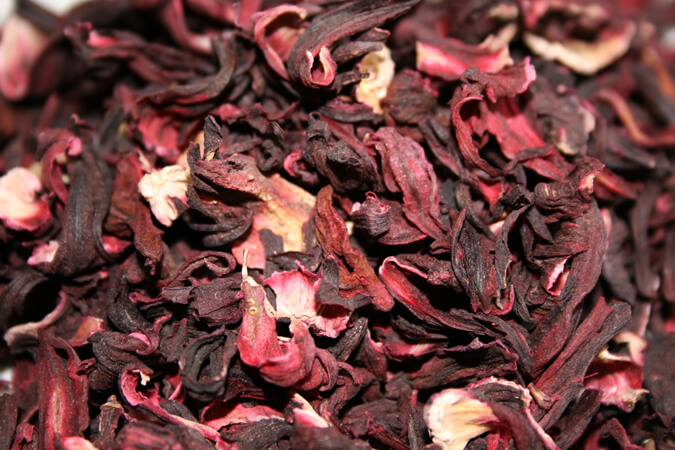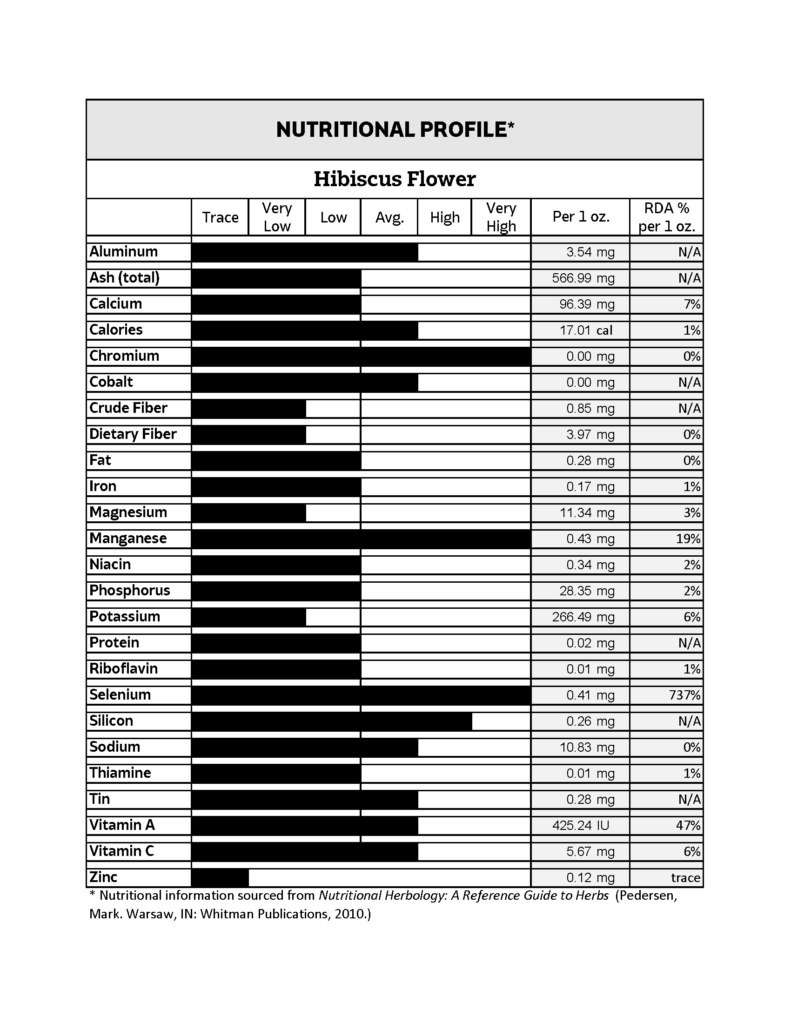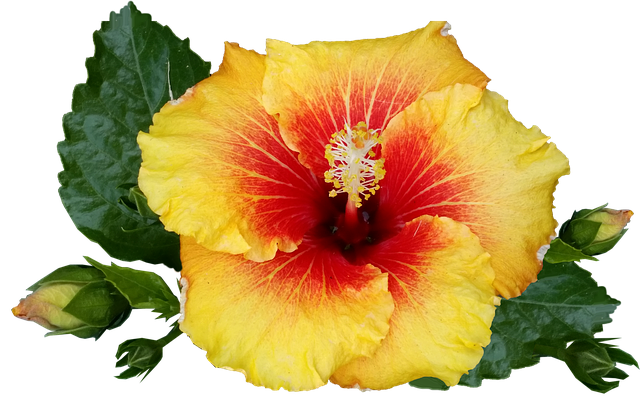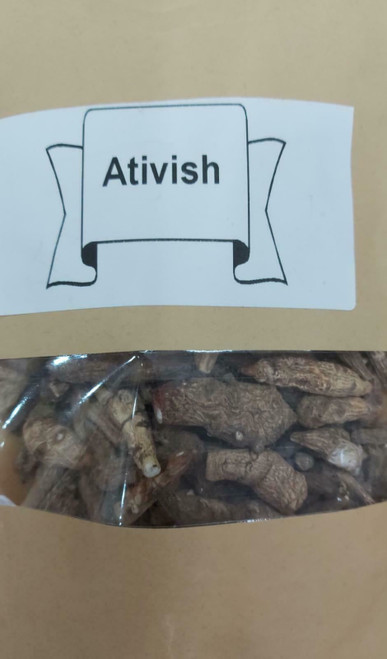Botanical Name: Hibiscus sabdariffa
Family: Malvaceae
Other Common Names: Roselle, agua/rosa/flor de Jamaica, sorrel, karkade, zobo, bissap, cranberry hibiscus, Florida cranberry, tea hibiscus
Parts Used: Calyxes, young leaves, young stems, seeds, roots, flowers
Energetics: Moist
Thermal Properties: Cool
Actions: Antimicrobial, antihelmintic, antidepressive, anti-inflammatory, antilithic, antimicrobial, antioxidant, antipyretic, cardiac tonic, demulcent, diuretic, hepatic, hypotensive
Taste: Sour (with hints of sweetness)
Plant Uses: Hibiscus is used to cool and soothe the body. It also has favorable qualities for modulating glucose levels, supporting steady energy, and reducing belly fat. Hibiscus supports heart, kidney, and liver health, and reduces inflammation.
Plant Preparations: Hibiscus is used to flavor and color many food items, including teas, foods, and vinegars. The leaves and petals are sometimes used as a substitute for the plant’s calyxes, and the entire plant is edible. Alcohol extracts are not common, due to alcohol’s poor ability to extract the mucilaginous properties of hibiscus.
Toxicities/Warnings: Hibiscus may interfere with the absorption and elimination of certain drugs. Its blood pressure– and blood glucose–affecting properties can potentiate the effects of drugs with the same indications. Pregnant women may want to avoid hibiscus, at least during the first trimester. Pets should not be given hibiscus at all.

[Attribution – “Popperipopp [CC BY 3.0 (https://creativecommons.org/licenses/by/3.0)]”]
Introduction
Many people know hibiscus as a decorative plant with large, colorful blooms. But less well known is that most (perhaps all) members of the Hibiscus genus are in some way edible. Hibiscus sabdariffa is especially prized for its use in teas and in other foods.
The name Hibiscus comes from the Greek word for marshmallow. This makes sense, because hibiscus is in the mallow family, which includes marshmallow, and shares several characteristics with it. The name sabdariffa is the common name for this species in West Indian.
Hibiscus sabdariffa is one of the most popular members of the genus, having been cultivated for thousands of years. It is used as a food and as a medicine throughout much of the tropical and subtropical world. Hibiscus has a pleasant, tart flavor, similar to cranberry, with light floral notes and just a hint of sweetness.
You May Also Enjoy:
“Hibiscus Tea Helps a Heart Stay Healthy”
“Heat Exhaustion – The #1 Threat to Summertime Gardeners”
“How to Dress for Working in the Heat”
Hibiscus is the basis for several regional drinks people use to help cool off during hot, tropical summers. As a member of the mallow family, hibiscus is slightly mucilaginous. The drink has no slimy or off-putting texture, but does help to lightly coat the throat and protect it from dryness and particulate irritants. On this note, let us move on to the next section and look into the many other benefits of Hibiscus sabdariffa.
Benefits
- Delicious: Hibiscus is an excellent beverage alternative for those wishing to cut out sodas, but wanting something more interesting than water.
- Demulcent: Sooth and rehydrate a parched throat, and quiet chronic coughs, with hibiscus tea.1)
- Energy Boost: Hibiscus supports healthy mitochondrial function and can speed up the metabolism.2)3)
- Heart Health: Blood pressure, cholesterol, and triglycerides are all positively affected by hibiscus.4)5)6)7)
- Anticancer: Studies are showing that hibiscus increases the rates of cancer cell death in leukemia and multiple forms of gastric carcinoma, and has a positive effect on prostate cancer.8)9)10)11)12)13)
- Support Healthy Weight: Hibiscus helps to reduce abdominal fat and fat in the liver.14)15)16)
- Support Healthy Cognition: Consuming hibiscus can help support clear thinking and memory.17)18)19)
- Stroke: Hibiscus tea helps to support a healthy blood pressure, which can reduce your chances of stroke. 20)
- Liver Protection: Hibiscus reduces the chance of fatty liver disease and protects the liver from damaging chemicals.21)22)23)24)25)
- Relieve Anemia: Consuming hibiscus products can help you maintain a healthy level of iron in the blood.26)27)
- Beneficial for Diabetics: Hibiscus can help improve insulin-resistance levels and glucose levels.28)29)30)31)
- Immune System: Hibiscus supports the actions of a healthy immune system in a variety of ways.32)
- Relaxing Mood Lifter: Hibiscus is a natural antidepressant, and can help relieve insomnia.33)34)35)
- Diuretic: Hibiscus helps to support healthy kidney function.36)37)
- Increased Antioxidant Capacity: Not only is hibiscus high in antioxidants, but it also increases your body’s capacity for antioxidants, helping to decrease oxidative stress.38)39)40)41)42)
- Kidney Stones: Hibiscus helps to prevent and flush out kidney stones.43)44)45)
- Decreased Inflammation: Hibiscus can help reduce harmful, chronic inflammation.46)47)
- Cooling: Whether you’re reducing a fever or just cooling off on a hot day, the cooling properties of hibiscus can help.48)
- Antimicrobial: Hibiscus has been shown to have antibacterial, antiviral, and antiparasitic power.49)50)51)52)53)54)
Medicinal Properties
A glass of iced hibiscus tea is more than an alternative to sugary sodas and juice. It helps to promote correct mitochondrial function and keep your energy levels steady.55)56)57) It’s a weight loss aid, too, helping people lose stubborn abdominal fat.58)59)60) Hibiscus also helps to prevent and remove fat formation in the liver and can act as a liver protectant against chemical damage.61)62)63)64)65)
Hibiscus seems to have an affinity for the circulatory system.66)67) It helps to reduce cholesterol and triglyceride levels, and has a blood pressure–lowering effect that was found to be more effective than commonly prescribed diuretic medications.68)69)70)71) This effect was most noticeable when hibiscus was taken over time.
Hibiscus can also help boost circulation to the heart and brain. Taking it regularly may help to decrease the chances of having a stroke or heart attack.72)
Also related to the blood, hibiscus has traditionally been used as a treatment for anemia.73) This use has now been validated by modern science. One study found that, when consumed as a food, hibiscus helped to maintain the iron levels in the blood of women of childbearing age.74)
Hibiscus also has several mind-related benefits. Hibiscus is a natural antidepressant and helps to relieve insomnia.75)76) It also promotes clear thinking and memory.77)78) In addition, hibiscus helps the body to balance glucose levels and increase insulin sensitivity, and may help to protect cognitive function in diabetics.79)80)81)82)
The high antioxidant levels of hibiscus help to absorb free radicals in the body and lower inflammation.83)84)85)86) Beyond this, hibiscus enhances the body’s ability to absorb and use antioxidants. This can help to increase the effectiveness of vitamin C in the body and generally increase the effectiveness of the immune system.87)88)
Hibiscus has great potential as an antimicrobial herb.89) It combats several bacterial and viral infections, and even some parasites.90) Hibiscus has been shown in studies to be effective against Helicobacter pylori, a bacteria that can cause ulcers; Escherichia coli; staph; and avian flu. It is a traditional treatment for shingles.91)92)93)94)
Hibiscus is a diuretic that helps to facilitate healthy kidney function.95) It increases urine volume to help flush out existing kidney stones and may may help to prevent future stones from forming.96)97)98)99)100)
You May Also Enjoy:
“Sugar and Heart Disease—How Lobbyists Purchased Decades of U.S. Dietary Policy“
“The 7 Stages of Home Medicine Makers“
Hibiscus also shows promise in anticancer treatments. Hibiscus extracts have been shown to decrease cancer formation and increase the self-destruction of cancer cells in multiple types of gastric carcinomas and leukemia. It has also been shown to have a positive effect on prostate cancer.101)102)103)104)105)106)107)108)
Nutrition Properties
While the hibiscus plant does contain several nutrients, most applications will use water-based extracts from the plant. Water-soluble nutrients will carry over, but the total nutrition will be lower than the amounts represented in the chart below.

How to Use/Prepare/Typical Dosing
Hibiscus Tea
- 4 cups water
- 1-2 Tablespoons dried hibiscus calyxes
- Sugar or honey to taste
Bring the water to a boil. Remove from heat and add hibiscus. Cover and allow to steep for 20 minutes. Hibiscus tea can be served hot or cold and is often served over ice. You can also cold brew hibiscus tea by letting the calyxes sit in water overnight. Hibiscus leaves are sometimes substituted for the calyxes when making tea or sorrel (see recipe below).
For a pleasant twist, steep with mint or lemongrass. You might also add a splash of lime juice. If you’re looking for a safe, natural alternative to sugar, use stevia in place of the sugar. It’s a plant-based, zero-calorie sweetener.
You May Also Enjoy:
“Top 10 Health Benefits of Stevia“
“17+ Benefits of Licorice: A Sweet Solution for Sore Throats, Digestive Issues, Allergies, and More!“
“Red Raspberry Leaf: Its Benefits and Uses“

Sorrel
Sorrel is a traditional drink made with hibiscus. Recipes vary from person to person. You can use a hot or cold brewing method. The quantities listed below are suggestions. Have fun altering the recipe to suit your own tastes!
Main Ingredients
- 8 cups water
- 1 cup dried hibiscus calyxes
Other Options
- 1 cinnamon stick
- 4 cloves
- Brown sugar to taste
- 1/2 teaspoon ginger powder or 1 thick slice of fresh ginger root
- A piece or 2 of orange peel
- 1 anise seed pod
- Rum, to taste
- Wine, to taste
Add all of the non-alcoholic ingredients to a stainless steel pan and bring them to a boil. Reduce heat and let the contents simmer for 20 minutes. Remove the sorrel from heat and allow it to cool. Add rum or wine, if desired. Your sorrel can be stored in the refrigerator for about a week. Serve with ice.
For the cold-brewed version, place all of the ingredients together, cover, and leave them overnight.
Sorbet
- 5 cups water (divided)
- 1 cup hibiscus calixes
- 1 cup sugar
- Lemon or lime juice
Bring 4 cups of water to a boil. Add the hibiscus and simmer for 20 minutes. Allow this to cool, and place it in your refrigerator. Let it sit for 8 hours. This will allow the flavors to continue infusing into the liquid.
Next, you will need to make a simple syrup. Dissolve 1 cup of sugar into 1 cup of water over medium heat. Allow the mixture to sit at medium heat for another 7 minutes. Now remove it from the heat and allow it to cool.
Remove your hibiscus tea from the refrigerator and strain out the calyxes. Combine 2 cups of hibiscus tea with 1 cup of simple syrup. Add 1-1/2 tablespoons of lemon or lime juice. Pour this into an ice cream maker, and let it run according to the manufacturer’s directions.
You May Also Enjoy: “Soothe a Sore Throat With Herbal Ice Cream”
Hibiscus Pancakes
Hibiscus can be u










